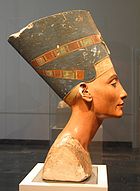Portal:Ancient Egypt/Selected article/5
The Nefertiti Bust is a 3300-year-old painted limestone bust of Nefertiti, the Great Royal Wife of the Egyptian Pharaoh Akhenaten and is one of the most copied works of ancient Egypt. Due to the bust, Nefertiti has become one of the most famous women from the ancient world as well as an icon of female beauty. It is believed to have been crafted in 1345 BC by the sculptor Thutmose.
A German archeological team led by Ludwig Borchardt discovered the Nefertiti bust in 1912 in Thutmose's workshop in Amarna, Egypt. It has been kept at several locations in Germany since its discovery, including a salt mine in Merkers-Kieselbach, the Dahlem museum (then in West Berlin), the Egyptian Museum in Charlottenburg and the Altes Museum. It is currently on display at the Neues Museum, Berlin, where it was displayed before World War II.
The Nefertiti bust has become a cultural symbol of Berlin, Germany as well as of ancient Egypt. It has also been the subject of an intense argument between Egypt and Germany over the Egyptian demands for its repatriation. It was dragged into controversies over the Body of Nerfertiti art exhibition and also by allegations regarding its authenticity.


